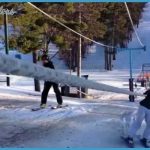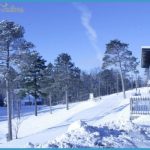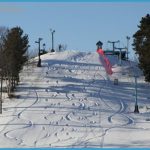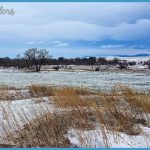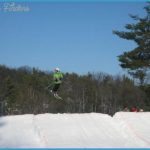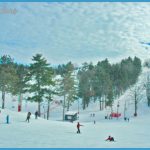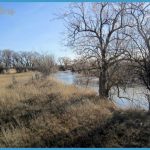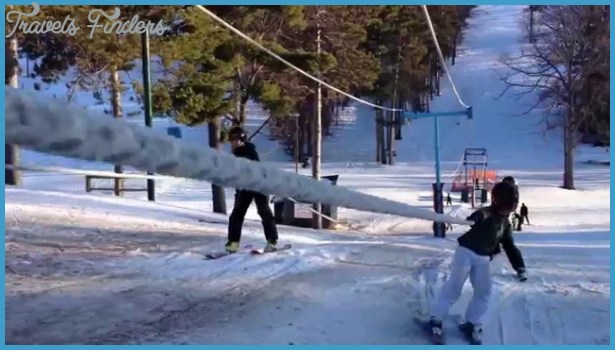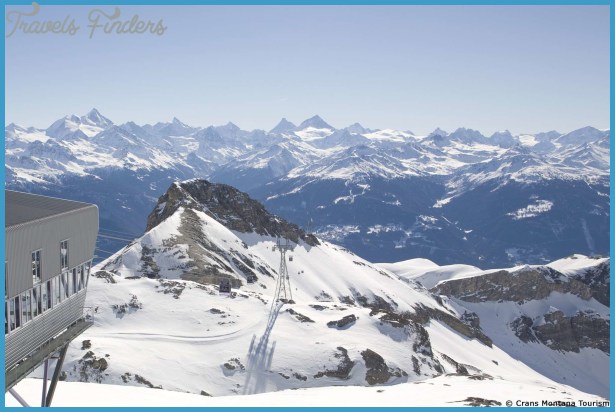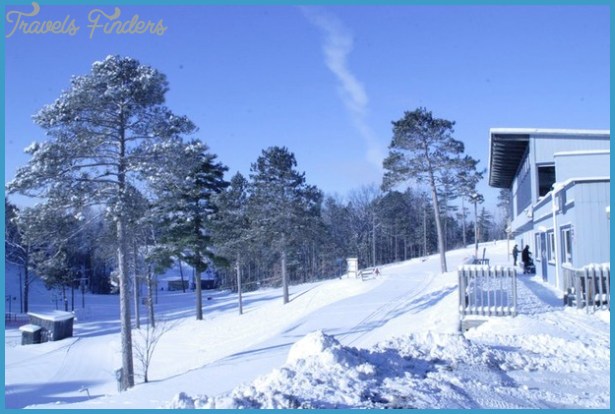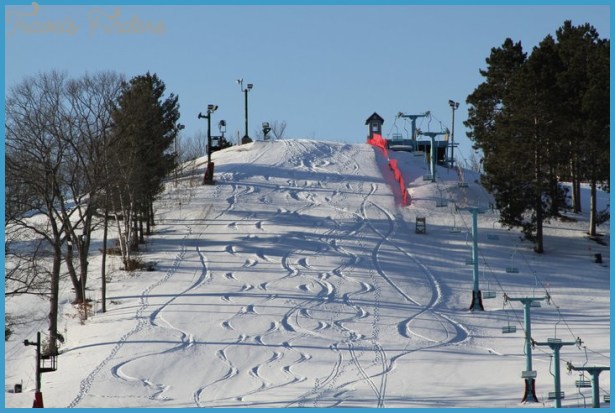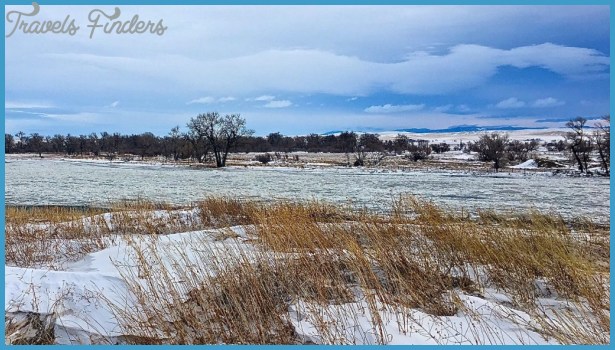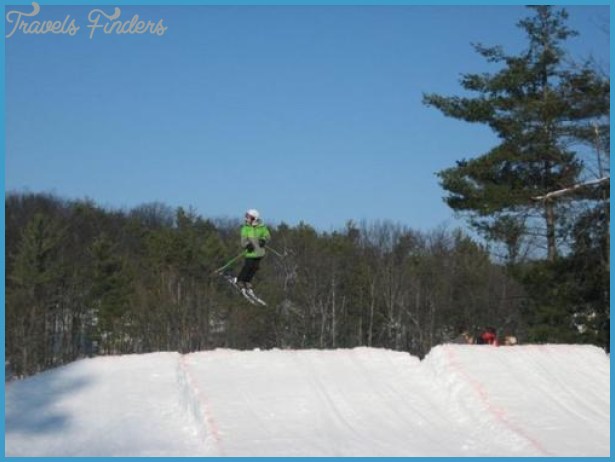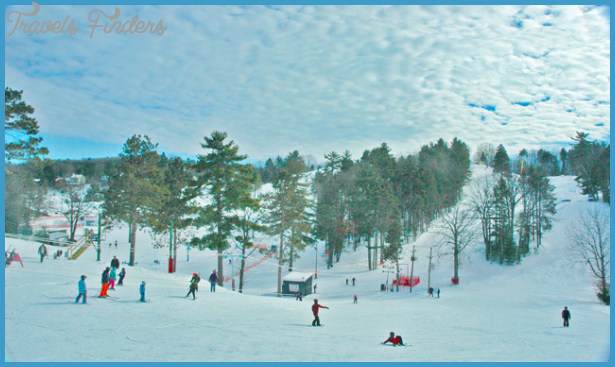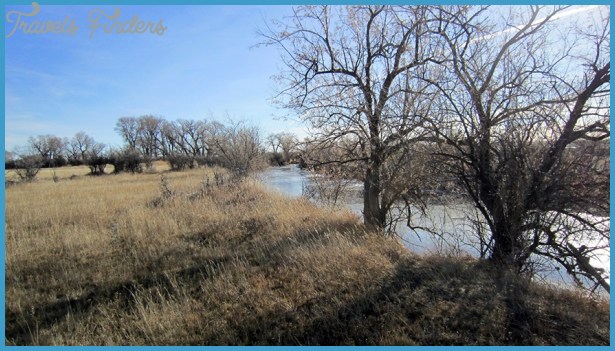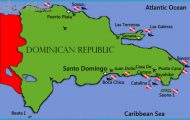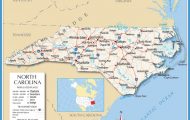TWO HUTTERITE CHILDREN FROM THE MILFORD COLONY FROLIC IN RAINWATER For the next 75 miles, wildlife, history, and western personalities are the name of the game. Augusta (pop. 309) is a sweet little cottonwood oasis near the Sun River, with great views of the Rockies. Latigo & Lace (406-562-3665, Mar.-Dec.) is a made-in-Montana gem with fine arts, pottery, photography, a wide array of books, an espresso bar, and a great deal more. Near Gibson, west of Augusta, is the Mortimer Gulch National Recreation Trail, a moderately challenging serpentine trek that features grassland views. This area is a popular starting point for hikers wanting to cross the Bob Marshall Wilderness Area and reach the sheer Chinese Wall, the Bob’s signature geologic feature.
THE OLD GILMAN BANK BUILDING IS NOW A PRIVATE RESIDENCE NEAR AUGUSTA
Inside the wilderness is the Sun River Game Preserve, established in 1913 as elk summer ranging grounds to salvage what was left of herds decimated upon the white man’s arrival. Thirty-four years later, with the ungulates finally thriving again, the Sun River Game Range & Wildlife Management Area was created on the Front Range for wintering elk. It is one of the finest places in Montana to see a big herd. If domestic four-legged critters are more to your taste, the Augusta American Legion Rodeo in late June is Montana’s oldest single-day rodeo.
Back on US 287, the highway eases away from the Front Range, but the views remain spectacular. About 25 miles northeast of Augusta is Choteau (pop. 1,694), which justifiably dubs itself The Front Porch of the Rockies. Choteau is a comfortable town that’s ideal for an overnight stay to explore the heart of this region. Before leaving, visit the Old Trail Museum (406-466-5332, May-Sept.), a collection of frontier buildings housing artifacts dating back to eras ranging from a century ago to millions of years ago. The museum, so named because it’s on the 25,000-year-old Old North
Trail once used by ancestors of the Blackfeet, is part of the state’s Dinosaur Trail. It also has an exhibit highlighting the life of A. B. Guthrie, Jr. the first great Western writer born and raised in Montana. Certain to elicit a double-take is the display of an old French trapper standing upright despite an arrowhead lodged in his spine.
While in Choteau, veer north on US 89, though if you’re a bird aficionado, take an hour-plus detour southeast about 12 miles to Freezeout Lake, a key spot on a migratory flyway for prolific flocks of waterfowl. In March, as many as 300,000 snow geese and 10,000 tundra swans from points south converge on their annual journey northward to Canada and the Arctic; they return in the fall. Other fowl and raptors are there year-round. Returning to Choteau, continue northwest on US 89 about 9 miles to the junction with Canyon Road, which follows the Teton River west past Eureka Reservoir and opens up the Front to a wide variety of recreation opportunities (see Side Tracks).
As you continue on US 89, note the Hutterite Miller Colony before arriving in Bynum (pop. 31), a diminutive town with a giant dinosaur in fact, the world’s longest. The Two Medicine Dinosaur Center (406-469-2211) is home to the skeletal display of a Seismosaurus and also features the remains of the first baby dinosaur found in North America. The museum has regular summer hours but requires an appointment during the rest of the year. While you’re there, ask about joining a dig at Egg Mountain, an excavated area beneath a rise on US 89 just south of Bynum. Fossilized eggs were found in ancient Maiasaura nests discovered there in 1983, and dinosaur bones are consistently unearthed to this day. Across the road from the museum in Bynum is the Trex Agate Shop (406-4692314), which has to be seen to be believed. John Brandvold’s selection and collection of rocks, gems, and artifacts is updated annually and rivals anyone’s anywhere. It was his wife, Marion, who found the first nest of baby dinosaurs at Egg Mountain in 1978, five years before the paleontologists. Her life is quite a story (she died in 2014 at age 102) and it’s well worth a sit and chat if you catch John, who was 20 years her junior. Like the museum, the shop has regular summer hours and is open by appointment at other times.
SIDE TRACKS
Pine Butte Swamp/Teton Pass Ski Area: Choteau to West Fork (60 miles)
Among the many desirable options for access into the alluring mountains dominating the western skyline, the one with the most bang for your half-day buck is Teton Canyon Road about 5 miles northwest of Choteau. A highlight is The Nature Conservancy’s 15,500-acre Pine Butte Swamp Preserve (406-443-8311, see sidebar), a vast and stunning plains wetlands complex at the edge of the mountains. For an extraordinary weeklong experience, you could arrange an all-inclusive stay at TNC’s Pine Butte Guest Ranch ($$$$, 406-466-2158, May-Sept.) and take part in nature courses, workshops, and conservation-related activities in stunning landscapes. Teton Canyon Road is straight and paved all the way to the mouth of the canyon, and along the way there are no fewer than three designated hiking trails epitomizing the diverse terrain: Mill Falls Trail is an easy hike through thick forest, Clary Coulee Trail represents the rolling prairie landscape, and Green Gulch Trail combines both with a nice dose of mountains. For winter enthusiasts, the picturesque Teton Pass Ski Area (406-466-2209) is a small family ski area with two lifts (no lines), twenty-six runs, and 1,010 feet of vertical drop. In the summer, continue past the ski area and over a small pass where the picturesque West Fork and its smattering of summer cabins unfolds far below. On the return trip, turn south on Bellview Cutacross Road past Pine Butte. Stop at the interpretive marker, grab your binoculars and take the short hike to a ridge offering an expansive view of the swamp. If you see a foraging grizzly bear in the distance, consider yourself among the fortunate few a mighty griz on the prairie is a rare sight indeed. Dusty Bellview Road back to Choteau offers a Guthrie-esque experience of sprawling ranches, a one-room schoolhouse, and a breathtaking rearview mirror panorama of a wall of mountains.
Recreation Road: Prickly Pear to Hardy (35 miles)
Don’t let a quick glance at a map dissuade you from taking this route, despite the presence of nearby Interstate 15. Recreation Road (and, later, the Craig Frontage Road) does parallel the moderately busy freeway, but you’ll hardly know it’s there as you follow Prickly Pear Creek and an abandoned Burlington Northern Santa Fe Railroad spur through a pretty canyon of vermillion rock before reaching the brawny Missouri River. Highlights include the fly-fishing meccas of Craig, Wolf Creek, and Tower Rock State Park. Coming north from Helena, exit I-15 onto Recreation Road just past the Sieben Ranch, owned by the family of longtime Montana Senator Max Baucus. Stay on what becomes Craig Frontage Road at Wolf Creek, which has two bar/restaurants, a gas station, a fly shop offering guided fishing on the Missouri, and accompanying lodging popular among fly anglers. After Wolf Creek, forested mountain terrain immediately opens up and it’s a couple of miles to the Wolf Creek Bridge over the Missouri. Two miles on gravel to the southeast is the dam backing up Holter Lake, which provides the explanation for the procession of driftboats and rafts you’ll see on the road and the river from this point all the way to Hardy and beyond to Cascade. The dam releases water from the bottom of the reservoir and this steady flow of clear, cool, nutrient-rich tailwater makes for at least 25 miles of trout fishing rivaling the Bighorn, Madison, and Yellowstone Rivers. Though the river doesn’t appear to change character much, it actually has four or five distinct sections where the approach to fishing changes. A bridge crosses the river at Craig, which you’ll readily notice is the hub of all of this fly-fishing activity. It has a vibrant bar/restaurant, several angling shops, and lodging. Less than five miles past Craig, the Missouri serpentines through another pretty canyon with a blend of modest year-round residences and trophy homes. The route ends at Tower Rock, a 424-foot-high igneous rock formation that served as an important landmark for traveling Indians. Explorer Meriwether Lewis described it as a tower in his journal in July 1805 and saw it as a gateway to the Rocky Mountains. Members of the party climbed the rock and expressed wonder at the thousands of bison on the prairie they’d just crossed. Tower Rock is a day-use area only and is worth a quick stop if you can ignore the landfill at its entrance.
Angling northwest of Bynum, the highway continues its rolling course toward Dupuyer (pop. 86), an endearing one-blink town along Dupuyer Creek. For goodies, the quaint Dupuyer Cache (406472-3272, 11am-5pm, Wed.-Sat.) combines many of the amenities of an old mercantile, from groceries and dry goods to local honey, crafts, and wool that comes from the Big Hole Valley.
A few miles outside Dupuyer is the southern boundary of the 3,000-square-mile Blackfeet Indian Reservation, home to about 8,500 tribal members. The once-powerful Blackfeet, frequently referred to as The Lords of the Great Plains, believe they were created on these lands about 6,000 years ago. The Blackfeet (it’s Blackfoot in Canada) call themselves Piegans or Pikanni. Among Indians, they have the unique distinction of retaining their most sacred lands, though it’s largely because Anglos had little use for the blustery high plains.
The Front: Where the Mighty Griz Roams the Prairie
Once upon a time, the mighty grizzly bear, king of the wilderness food chain, roamed the
Great Plains by the tens of thousands. But by the late 1800s, westward Anglo expansion and a determined extirpation effort pushed the great bear into small mountain nooks, mostly in Greater
Yellowstone and the Crown of the Continent bordering Canada at present-day Glacier National Park.
A notable exception is the Pine Butte Swamp Preserve, where the grizzly has continued its annual spring migrations from the expansive Bob Marshall Wilderness Area to the prairie. In 1979, The Nature Conservancy purchased these 15,500 acres of foothills, prairie, and a 500-foot sandstone butte solely to provide a lowland outlet for the grizzly, which arrives via the Teton River riparian corridor.
Grizzlies have made a solid comeback in the Northern Rockies in the past three decades, though they remained under Endangered Species Act protections as of mid-2015 because of uncertainty over the future of some of their primary food sources. Except for the Pine Butte Swamp Preserve and a small slice of the Blackfeet Indian Reservation to the north, though, they still generally aren’t tolerated on the prairies.
Our willingness to live with these majestic and fearsome creatures is being tested. With grizzly numbers expanding in wilderness areas and national parks, more are wandering onto the grasslands in search of new space. Some have roamed as far as 100 miles onto the plains here. Montana wildlife officials typically trap the bears and return them to the wilds. Grizzlies are occasionally seen in creek bottoms all along the Front and have been in Dupuyer. Expectations are that grizzlies will continue to move to lower elevations in search of food, raising fears of increased conflicts between humans, livestock, and bears. When that happens, bears usually die.
At Pine Butte, the mindset is different. It’s the bear’s world, and humankind is to tread lightly. Spend a week here in the summer or just visit for a weekend in the spring or fall, and marvel at the idea that somewhere amid the cottonwood and juniper in a creek bottom, a grizzly is contentedly living the way its ancestors did more than a century ago.

